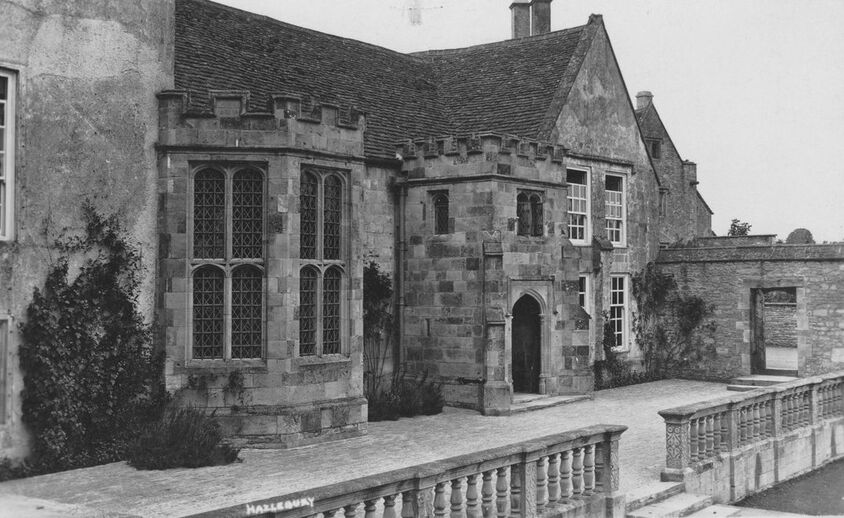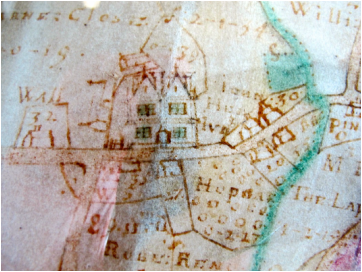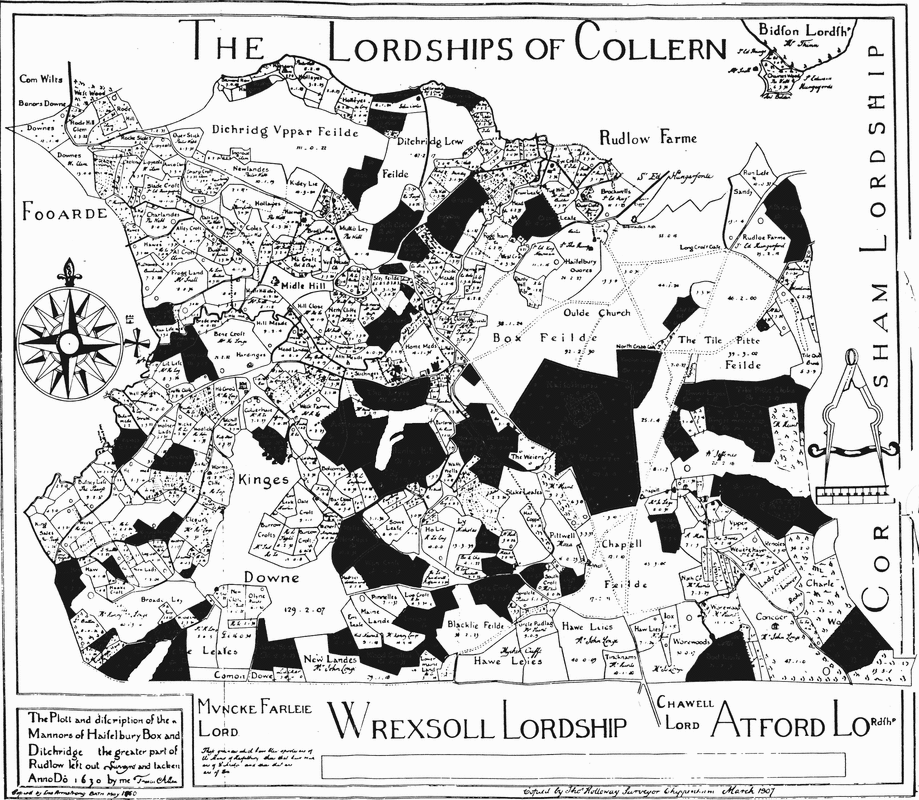Hugh Speke: The Man Who Shaped Box Alan Payne October 2015
We know little about the ancestry of Hugh Speke, who became lord of Box Manor in 1602 when he bought the old Bonham estate from Sir John Young, including the lay manors of Box, Hazelbury and Box Agard;[1] the advowsen of Box Church; and other land in Box, Hazelbury and Wadswick. There is no picture of the man, we don't know when he was born and we know very little about the source of his wealth.
He appears to have been the younger son of a Somerset family, who invested an inheritance from his mother in the Box area.[2] His family were knights, sheriffs and Members of Parliament in Somerset and Dorset and they had been the chief stewards of Glastonbury Abbey after its dissolution. But they were far from being fabulously wealthy. Possibly Hugh came to rural Box as a shelter because the family was recusant (Catholic); he appears to have avoided controversy, kept his head down and avoided matters of religion.
Speke Assets
We do know that he acquired a huge property estate in the years from 1603 until his death in 1624: land at Henley in 1604; land at Wadswick, Box and Hazelbury in 1608; land in Wadswick, Box field and Chapel field in 1608; he bought the ecclesiastic manor that Farleigh Priory had built up in Box from the Earl of Hertford in 1609; a tenement in Batheaston in 1609; land in Rudloe in 1609-10; land in Hawthorn, parts of the common fields in Hazelbury and Box in 1610; land at Kingsdown in 1610-11; tenements in Box in 1613; land in Batheaston in 1616; land and cottages in 1624; land in Ditteridge relating to the dissolved abbey at Lacock.
He appears to have been the younger son of a Somerset family, who invested an inheritance from his mother in the Box area.[2] His family were knights, sheriffs and Members of Parliament in Somerset and Dorset and they had been the chief stewards of Glastonbury Abbey after its dissolution. But they were far from being fabulously wealthy. Possibly Hugh came to rural Box as a shelter because the family was recusant (Catholic); he appears to have avoided controversy, kept his head down and avoided matters of religion.
Speke Assets
We do know that he acquired a huge property estate in the years from 1603 until his death in 1624: land at Henley in 1604; land at Wadswick, Box and Hazelbury in 1608; land in Wadswick, Box field and Chapel field in 1608; he bought the ecclesiastic manor that Farleigh Priory had built up in Box from the Earl of Hertford in 1609; a tenement in Batheaston in 1609; land in Rudloe in 1609-10; land in Hawthorn, parts of the common fields in Hazelbury and Box in 1610; land at Kingsdown in 1610-11; tenements in Box in 1613; land in Batheaston in 1616; land and cottages in 1624; land in Ditteridge relating to the dissolved abbey at Lacock.
|
Hugh was wealthy as evidenced by his loan of £30 to the king in 1611, one of the most generous in Wiltshire.[3] We also know that he redeveloped some of the properties that he acquired including the Manor House in the centre of the village and Hazelbury Manor. In the end he owned an incredible land bank, acquired from scratch.
Now, for the first time, we can discover more about him by reviewing the way that he owned and leased this land to tenants based on his will and that of his children. Right: Hazelbury Manor depicted in Francis Allen's 1630 map (courtesy Wilts History Centre) |
Land Owned by Speke
Hugh owned his land in a new way; no longer the old feudal tenure based on military service owed ultimately to the king, but rather by a new legal basis, freehold tenure. With two exceptions all of his land was held in this way. By the time of Hugh's death in 1624 the only exceptions were Box manor which was held of the King in chief by knight’s service, but by what part of a knight’s fee the jurors are ignorant. The only complete example of feudal tenure was land acquired from Sir William Butten which was held in socage (a fixed amount), by fealty (oath of allegiance), and the annual render of half-a-pound of pepper.[4]
Hugh's land transactions may appear haphazard (perhaps opportunist) but they were part of a plan of reorganisation which dramatically altered the structure of Box's agricultural land holdings. We need to explain what he did with the property he bought, particularly the land in the arable common fields, such as from Richard Beaser: 18 acres of arable land in the field called Tile quarre field and Chappell field.[5]
Many deals were of minute areas in Box's arable common fields. He acquired odd selions (strips) of land: from John Moxsam two acres in Chappellfield, half an acre in le Quarrefield; and from George Mison one acre of meadow lying in the Engolls meadowe in Box.
Sometimes he bought the grazing rights that went with the common field strips: from Thomas Browne 2 acres of land in the fields of Box, common of pasture, in the fields aforesaid, for 25 sheep and 2 rother (oxen) beastes; from William Horton common of pasture; from Henry Woodman 2 acres of land in the common fields there for all their cattle.
Speke bought these individual selions (strips) in open fields by private agreement with the numerous owners and he rationalised them into small blocks of land contained within hedges and fences. He converted arable land into small pasture fields and any rights the owners had in common meadow or pasture were cancelled.[6] These self-contained smallholdings were rented out and the income used to buy more property.
Hugh owned his land in a new way; no longer the old feudal tenure based on military service owed ultimately to the king, but rather by a new legal basis, freehold tenure. With two exceptions all of his land was held in this way. By the time of Hugh's death in 1624 the only exceptions were Box manor which was held of the King in chief by knight’s service, but by what part of a knight’s fee the jurors are ignorant. The only complete example of feudal tenure was land acquired from Sir William Butten which was held in socage (a fixed amount), by fealty (oath of allegiance), and the annual render of half-a-pound of pepper.[4]
Hugh's land transactions may appear haphazard (perhaps opportunist) but they were part of a plan of reorganisation which dramatically altered the structure of Box's agricultural land holdings. We need to explain what he did with the property he bought, particularly the land in the arable common fields, such as from Richard Beaser: 18 acres of arable land in the field called Tile quarre field and Chappell field.[5]
Many deals were of minute areas in Box's arable common fields. He acquired odd selions (strips) of land: from John Moxsam two acres in Chappellfield, half an acre in le Quarrefield; and from George Mison one acre of meadow lying in the Engolls meadowe in Box.
Sometimes he bought the grazing rights that went with the common field strips: from Thomas Browne 2 acres of land in the fields of Box, common of pasture, in the fields aforesaid, for 25 sheep and 2 rother (oxen) beastes; from William Horton common of pasture; from Henry Woodman 2 acres of land in the common fields there for all their cattle.
Speke bought these individual selions (strips) in open fields by private agreement with the numerous owners and he rationalised them into small blocks of land contained within hedges and fences. He converted arable land into small pasture fields and any rights the owners had in common meadow or pasture were cancelled.[6] These self-contained smallholdings were rented out and the income used to buy more property.
Enclosure and Improvement
We have evidence of the huge amount of this enclosure work shortly before the death of Hugh Speke’s son, George, when a Declaration of Trust dated July 1655 refers to a messuage of Haselbury and all those inclused (enclosed) grounds called Green Conigre, North Conigre, Chapel Conigre and Horse Close being enclosed with a stone wall.[7]
The Trust deed goes on to describe: that range of meadow ground called Box farm meads lying behind Box farm house with the parcels of Hugh Speke in the Common fields called Box Common field, Tilequarre Common Field, Chapple Common Field, containing 260 acres, 200 of which were lately enclosed by Hugh Speke. Two hundred acres is an enormous amount of land enclosed within a period of just two decades. It totally changed the appearance of Box's landscape.
The enclosure by private people like Hugh Speke led to a dramatic shift in social attitudes. The laws against enclosure were repealed in 1624 when Protestants were able to establish an important principle: that improvement by individuals wasn't a sin.[8]
There is evidence of farming improvements in the hay fields along the By Brook opposite Saltbox Farm, where lines of reeds mark out sluice channels which remain wet even in summertime. Probably there were sluice gates to control the flow of water back into the brook and it is possible that the gate at Saltbox Farm controlled water to the hayfields as well as Drewetts Mill.
Francis Allen’s 1630 map of The Mannors of Haiselbury, Box and Ditchridge shows how far the enclosure had gone. Box was composed mostly of small fields (10 to 20 acres) in layouts that we still recognise today and the common land reduced to just 130 acres. Of the old open strip field system, only isolated pockets survived as a reminder of Box’s agricultural Saxon history. Many of the enclosed fields had a cottage for the residence of the new tenant in small enclosed areas suitable for animal husbandry. The map was a working document, made to record the estate left by Hugh Speke to his son George in 1624.[9]
We have evidence of the huge amount of this enclosure work shortly before the death of Hugh Speke’s son, George, when a Declaration of Trust dated July 1655 refers to a messuage of Haselbury and all those inclused (enclosed) grounds called Green Conigre, North Conigre, Chapel Conigre and Horse Close being enclosed with a stone wall.[7]
The Trust deed goes on to describe: that range of meadow ground called Box farm meads lying behind Box farm house with the parcels of Hugh Speke in the Common fields called Box Common field, Tilequarre Common Field, Chapple Common Field, containing 260 acres, 200 of which were lately enclosed by Hugh Speke. Two hundred acres is an enormous amount of land enclosed within a period of just two decades. It totally changed the appearance of Box's landscape.
The enclosure by private people like Hugh Speke led to a dramatic shift in social attitudes. The laws against enclosure were repealed in 1624 when Protestants were able to establish an important principle: that improvement by individuals wasn't a sin.[8]
There is evidence of farming improvements in the hay fields along the By Brook opposite Saltbox Farm, where lines of reeds mark out sluice channels which remain wet even in summertime. Probably there were sluice gates to control the flow of water back into the brook and it is possible that the gate at Saltbox Farm controlled water to the hayfields as well as Drewetts Mill.
Francis Allen’s 1630 map of The Mannors of Haiselbury, Box and Ditchridge shows how far the enclosure had gone. Box was composed mostly of small fields (10 to 20 acres) in layouts that we still recognise today and the common land reduced to just 130 acres. Of the old open strip field system, only isolated pockets survived as a reminder of Box’s agricultural Saxon history. Many of the enclosed fields had a cottage for the residence of the new tenant in small enclosed areas suitable for animal husbandry. The map was a working document, made to record the estate left by Hugh Speke to his son George in 1624.[9]
References
[1] Box Agard was established in about 1395 when the Moleyns family sold their Box estate to the Hastings family - see Victoria County History of Wiltshire, Vol 8, Warminster Manors, Cheneys Manor
[2] GJ Kidston, History of the Manor of Hazelbury, 1936, p.189-191
[3] Wiltshire Archaeological and Natural History Society, Vol II, p.186
[4] GJ Kidston, History of the Manor of Hazelbury, p.315-322
[5] GJ Kidston, History of the Manor of Hazelbury, p.315-322
[6] WE Tate, The English Parish Community, 1967, The Camelot Press, p.61
[7] www.charters 10/wiltshireE1/29/1D/1
[8] Keith Wrightson, Early Modern England, Yale University, iTunesU, Chapter 16
[9] The map was redrawn in 1907 by Thomas Holloway, Surveyor in Chippenham. This version is available at Wiltshire Hisyory Centre, Chippenham
[1] Box Agard was established in about 1395 when the Moleyns family sold their Box estate to the Hastings family - see Victoria County History of Wiltshire, Vol 8, Warminster Manors, Cheneys Manor
[2] GJ Kidston, History of the Manor of Hazelbury, 1936, p.189-191
[3] Wiltshire Archaeological and Natural History Society, Vol II, p.186
[4] GJ Kidston, History of the Manor of Hazelbury, p.315-322
[5] GJ Kidston, History of the Manor of Hazelbury, p.315-322
[6] WE Tate, The English Parish Community, 1967, The Camelot Press, p.61
[7] www.charters 10/wiltshireE1/29/1D/1
[8] Keith Wrightson, Early Modern England, Yale University, iTunesU, Chapter 16
[9] The map was redrawn in 1907 by Thomas Holloway, Surveyor in Chippenham. This version is available at Wiltshire Hisyory Centre, Chippenham


